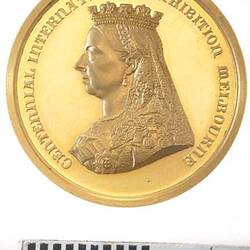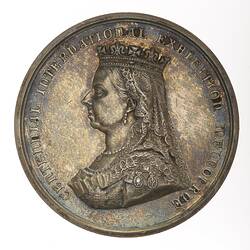On 28 May 1888 the Executive Commissioners for the Melbourne Centennial International Exhibition advertised a competition for the design of a medal and certificate to be given to exhibition prize-winners. A payment of 100 guineas would be given to the winner in each category. The medal designs were to be modelled in relief, and the designs for the certificate to be drawn in Indian ink. The medal was to show the Queen's head in profile on the obverse, and a 'suitable design' on the reverse. Nineteen designs for the medal were received, and fifty two designs for the certificate. A sub-committee from the Fine Arts Committee was appointed to select the winners, and on 18 January Ernst A. Altmann, a Melbourne die-sinker and engraver, was selected as the winner of the medal design, and Mrs Mary Stoddard the winner of the certificate design.
The Royal Mint was asked to strike the medal, but Deputy Master George Anderson reported that some of the relief was almost undercut, requiring unusual pressure, and was not feasible. This had happened to Altmann before, when his winning design for the 1880 exhibition medal was also rejected. Altmann was too unwell to re-work his design, so George Anderson was asked to both design and execute the medal. The dies were to be engraved by Stokes & Martin. Anderson set to work, and produced a medal that featured Queen Victoria's head on the obverse, based on the Jubilee medal by Sir Joseph Edgar Boehm, except that the crown had been replaced by a 'more firmly seated one which is seen in the New Zealand war medal'. On the reverse he provided a wreath composed of the leaves and acorns of British oak and the leaves and acorns of the wattle. The oak and wattle were tied together 'by a true-lover's knot, 'symbolizing the unity and affection between the mother country and the colony'. The motto 'Artibus dignis, honor insignis' - meaning 'to the deserving arts, distinguished honour' - was placed within the wreath, encircling the Southern Cross.
The medals were minted in gold, silver and bronze, in 1-1/2", 2" and 3" in diameter respectively. The first medal was presented to Governor Sir H. B. Loch on the day of his departure from Victoria, 15 November 1889, 10 months after the close of the Exhibition.
More Information
-
Keywords
-
Authors
-
Article types
![[NU 16453] Medal - Melbourne Centennial International Exhibition, Gold, Opening Presentation, Australia, 1888 (AD) (MEDALS)](/content/media/9/177059-small.jpg)


